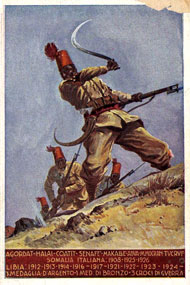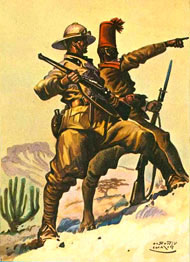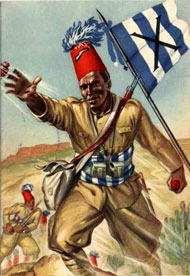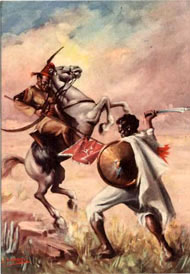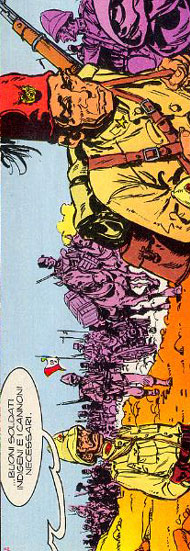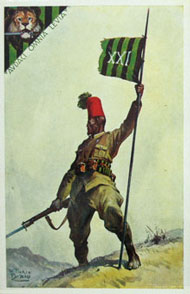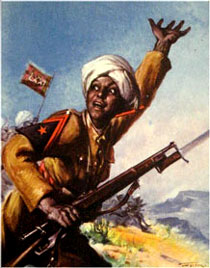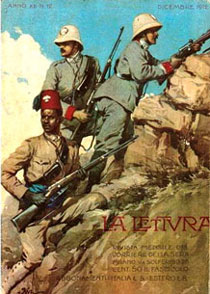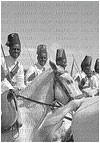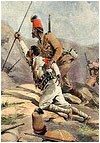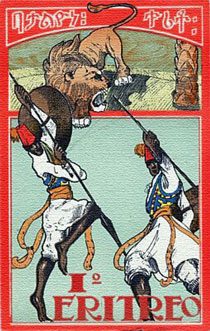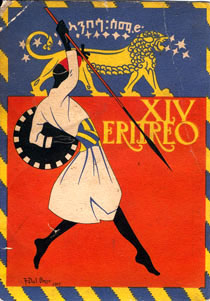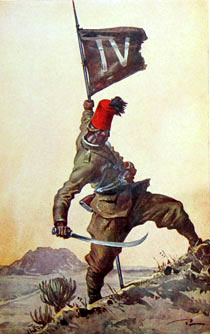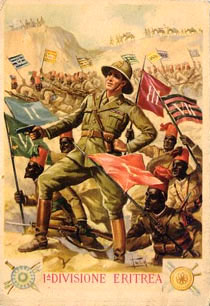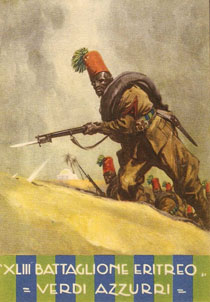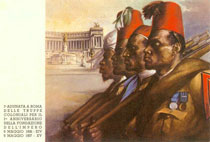Controstoria. ETIOPIA TRA MITI LEGGENDE E.....FINZIONE.
Traduci in italiano >>>
The lethal myth of Abyssinia: the ‘Ethiopia’ Hold Up
The various oppressed peoples of the most inhuman African tyranny, namely Abyssinia, have their own viewpoint over the atrocious metamorphoses of the hideous rule of the Amhara and Tigray minorities; the overwhelming majority of the tyrannized Oromos, Ogadenis, Sidamas and Afars, without being historians, can describe in the most accurate and yet colourful way the numerous, successive, failed efforts of transformation of the relic bogus-institution "Ethiopia"; as a matter of fact, the only fate this hideous tyranny deserves is not transformation but annihilation. And whether colonial criminals in Paris and London like it or not, this will come before too long.
I am glad to present here another illuminating text by the great Oromo intellectual Rundassa Eshete, whose trajectory from Africa to Russia and then to the States is a proof of his identity as Citizen of the World. In the first part of his article, Mr. Eshete focuses on earlier tyrannical Abyssinian regimes’ propaganda. The second part concerns the present regime’s propaganda of historical falsehood. I believe we can all take a lesson of Humanism, going through a text that exposes perfectly well the Oromo viewpoint on the polarization between the reality of the Oppressed and the myth of the Tyrants.
The Abyssinian Myth and Reality
By Rundassa Eshete
The Amhara and the Tigre share a 3000-year old myth geared to link themselves to king Solomon of Israel. We, the Oromians, and the rest of 93 ethnic group of southern Ethiopia have no quarrel with this myth because this Abyssinians’ myth may have some fact in it when it comes to the origin of these two tribes, namely the Tigre and Amhara.
How ever, we the people of south Ethiopia strongly resent what these two groups have done to us during the last 129 years. That is why we condemn and refuse to take pride in the history of heinous crimes, wanton violations of individual human rights, and national dignities of the last century.
Amhara / Tigre expansion to the South took place in the late 19th century under the leadership of Emperor Menelik II whose underlying ambition was to loot as much as possible wealth from Biyya-Oromo (homeland) and the land of other nationalities through continuous expansion of his borders until he was stopped because of the threat of European Colonial Powers stationed in Somalia . After he crossed into the heart of the land of the Somalis, he was forced to negotiate the current Ethiopian borders with the British, the Italians and the French who controlled divided Somalia at those days. It is to be reminded that the UN recognized Ethiopia ’s current territory during Haile Selasie’s imperial rule.
The negotiations between the European colonial trio and Menelik ended with an agreement, and according to its terms Menelik would promote and help expand Euro-centric religious ideology, which he did by killing 5 million Oromos, men and women, in 1896. In return, European Colonials would fund his task of murdering those whom they called "Gallas", which meant ‘savages who do not accept the light of Jesus Christ’. This agreement did help Menelik tremendously as he received European recognition under the coverage of the myth of the 3,000-year old, great Ethiopia, a myth that had absolutely no relevance. Besides, it would be wise to wonder why no other nation in Ethiopia believes in this myth except the Abyssinian Amhara and Tigre whose stakes hinge thereon. Simply put it, the history of Amhara / Tigre dominance over the peoples of the south then dates only as far back as the beginning of the Menelik Empire.
Nevertheless, the myth that has been established by Menelik just 120 years ago not only helped the perpetrators (the Tigre /Amhara tribes) and their descendants to propagate their supposedly glorious past, but it also enabled them to convince the Westerners that they would be a worthy and close ally; finally they obtained Western approval to accomplish their objective of enslaving native Africans, like the majority of the Oromians, an act they perpetrated without shame, remorse or regret.
For example, the Clinton administration was in the process of sending military aid to three African countries that collaborated to help overthrow the militant Islamic regime in Sudan, which was regarded by Washington as a key sponsor of international terrorism at those days.
Nearly US $20 m in surplus U.S. military equipment was sent to Ethiopia, Eritrea, and Uganda and these three countries were also ordered to help Christian Southern Sudan by preparing a joint offensive to topple the Khartoum government.
During that time, Secretary of State Warren Christopher made a visit to Ethiopia and CIA Director John M. Deutch also made a 3-day visit to Ethiopia, a country they referred to as a "frontline state" that finally received in fact US $106 m in total U.S. assistance during that fiscal year regardless of the ceaseless murders committed against thousands of Oromo youth by the Tigre tribal administration that the Westerners had put in power in 1991.
Here we know that the Westerners never ever shied from telling the truth about their "national interest" for what they go to war or spend billions of dollars financing people like Mobutu of Zair and Mubarak of Egypt; the same happens with the Abyssinian dictator ‘Melesovic’ Zenawi, simply in this case the assistance and support from the US government to the Tigre tribe is a continuation of the colonial trust established in the 19th century following the myth introduced by Menelik in 1800s. As a consequence, America and Britain name the modern descendent of the mythical Abyssinian as "the new African breed" just because he works to fulfill the myth the Westerners appreciate so much. As a result, the present Abyssinian Tigre minority government led by Meles Zenawi sought to restore close security ties with Washington in order to become the cornerstone for U.S. policy in the Horn of Africa region.
Of course, the Tigre tribe minority has learned how to produce reality show whereby the present ‘images’ from Eastern Oromia that reveal massive killings of Amharas that they blame on the Oromo Liberation Front! How comical that nobody wondered how Tigre-led TPLF teams could possibly shoot the movie in front of OLF fighters who would have killed that team first! It would be relevant of farce to think that the OLF called the TPLF team inviting them to planned massacres of Amharas, as they shamefully pretend.
Quite interestingly, the Tigre administration produced another forgery whereby a Tigre security officer acting as a fanatic Sudanese Muslim played the theater of attempting to assassinate Egyptian President Hosni Mubarak in Addis Ababa in June 1995. This theatrical affair and forged movie did hit its intended goal, namely to earn TPLF US praise for its loyalty to America, while at the same time hardening U.S. relationship with Sudan for its supposed involvement in the attempted murder of Mubarak. Furthermore, the forged movie helped the Tigre tribe government to force Sudan to shut down OLF office and radio station in Sudan and to stop assisting it. At the same time, it placed ‘Melesovic’ Zenawi on a regionally influential position from where he could control Oromian refugees and assassinate men like Jatani Ali in Kenya, Muli’s Abbaa Gadaa in Somalia, plus thousands in Djibouti. He even succeeded to have many Oromians arrested in Yemen and deported from there back to Abyssinia.
‘Melesovic’ Zenawi, via this reality show that was produced at a fair cost, strengthened his reign in Ethiopia, and more recently he took further his "tactical" and "cosmetic" steps, enjoying economic benefit as long as the term "terrorism" remains associated with Islam.
Since Mr. Bush came to power in America, ‘Melesovic’ Zenawi’s relationship appeared to represent a subtle distinction, as US administration officials conceded that Abyssinia got new military aid; it was with that help that Zenawi invaded Somalia and may be he is trying to provoke also a war with Sudan by using the Darfur incidence.
Eritrean President Isayas Afeworki has also received some assistance from the U.S. and even said "We are no longer prepared to play Tom and Jerry games with Khartoum. The stability of the region depends on the regime's defeat. There is no more room for diplomacy and no compromise".
U.S. officials estimate that more than 3,000 Sudanese rebels are marshaling in Eritrea for a joint offensive that is expected to concentrate on cutting the vital road running from Khartoum to Port Sudan .
So, mythical Abyssinia is not only a Jewish state via its forged myth but also a Western government and a genuine conduit for the expansion of Western ethnocentric views and ideologies that they dream to shape the entire world with. With the initial US $15 m in military aid for the three countries, involving US $7.3 m earmarked for Ethiopia and US $3.85 m each for Eritrea and Uganda, invading Somalia and enslaving the Oromians is a simple task, and eventually more money may be needed for Tigre administration of Abyssinia to implement the long term plan of building numerous , vast prisons throughout Oromia.
For other nations, history is may signify a real re-birth, but in Abyssinia, the Tigre tribes repeat the history of their forefather Menelik, who promised to build a strong Christian Empire by withstanding Muslim incursion and expansion. To prove this assessment of mine, one must look at the demographic details of Abyssinia and evaluate otherwise hidden realities. For example, the Muslims constitute more than 50% of the total population but the country has always been, and is still being identified as a …. ‘Christian island’. As it was historically customary for conquerors, the empire subjected the mostly Muslim southern nations therefore turning them to a booty for plunder and pillage with no legal, moral or ethical limitations.
Their arrogance, or to put it better their political ignorance, shows in that - to heal the lethal wounds caused by their system - they suggest no acceptable platform other than their ‘hollow’ democracy and federation, namely a form of federation whereby a small tiny tribe rules over majority which is constituted by the Oromians and the other southern and eastern nations of Abyssiniia; so democratic is the system they suggest that they have planned to indulge themselves to murdering whomever they want and whenever it pleases them.
Just like Menelik and Haile Selassie, the Tigre-led government of Abyssinia, typically personified by Melesovic Zenawi, prescribes an ethnic federation like the present system ruled by Tigre and Oromian individuals; however, this kind of federation cannot be the result of an imposed from above, imperial, unity. True federation can only be established following a democratic consensus whereby independently and democratically taken decisions within each different nation of the federation are proportionally represented in the Federal Assembly, and subsequently within the government.
However, like a reality movie producer, the Tigreans will never accept such a system, as long as they are the beneficiaries of the present system; it is thus logically expected that their dishonesty will continue until they are forced out of Finfinnee.
The Amharas’ myths
As far as the Amhara tribe is concerned, one must admit that they must have learned something from the jailing of their leaders; by now they know how it feels to be oppressed, even in cases you are allowed to establish political parties and to speak freely. In other words, prideful Amharas now know that they are subjected to the same Tigre manipulations like all other nations and that they must be ready to accept equality with the other nations of Abyssinia, Consequently, they must understand that they have to stop crying for their dying empire and start contributing to the abolition of Abyssinia’s imperial structures once forever. The imprisoned Amhara leaders should rather start thinking about a form of unity that could eventually be possible within a new Abyssinia whereby nations should be first asked in a referendum whether they want to belong or not.
During the past seventeen (17) years, we have witnessed the fact that the Tigreans exhibited a certain degree of preparedness to revenge their old leader Yohanes, who was killed in a border clash with the Sudanese before facing Menelik of Amhara region. This is the reason they see themselves as the lone leaders of Ethiopia. We also know that Amharas feel that ruling the south is their affair and that the Oromians ‘belong’ to them because Menelik settled them in Oromia as soldiers, in areas he conquered; however, the truth is that the land of Oromia still belongs to the Oromians, even if one third of Oromia was given as lot to his Amhara soldiers, one third to the Coptic Church of Abyssinia, and only the rest was left to the indigenous people. During the implementation of this project, the Southern peoples not only lost the third of land that was originally granted to them by decree, but also their human dignity and pride as they became serfs in service on the land of the Amhara soldiers and the Abyssinian church.
For several years, they could not leave the land unless evicted, they could not sent their children to school without the permission of their masters, the Amhara solders, and they could not own or carry weapons other than farm implements. Continuous campaigns of dehumanization were carried out through popular songs and sayings to make Oromos accept that they were inferior beings to the Amharas, uncivilized and cowards.
It was inhumanly hard on the Oromo as they formed the majority of the people of the Ethiopian Empire. The people tilled the land for the soldiers, and later for their descendants for most of the days in a week and, in addition, they were required by law to hand over three-fourths of the produce of their own fields. This same Menelik is portrayed by Amhara ideologies as the Architect of the Modernization of Ethiopia. It may be so, but what is true for the conquerors is not necessarily true for the conquered.
The successors of Menelik, conscious through wars and contemporary contacts, semi-modernized their governance to challenge the serfdom, and to free the peasant system, thus requiring the peasant to pay out only three-fourths of his produce to his landlord. As a preoccupation the successor group consistently tried to develop the ideology of Amharism and impose it on the southern peoples.
The purpose of all these superficial changes is to retain the unity of Ethiopia ; the country of their forced creation. The content of the ideology is simple. It was geared to
1. re-‘create’ the greatness of Abyssinia by diffusing the myth of 3,000 years of history,
2. establish the legitimacy of Amhara superiority in terms of rule,
3. develop the Amharic language to replace all other languages,
4. embrace the Coptic Abyssinian belief as the preferable sect of the Christian Religionm without openly combating other sects,
5. openly discourage the spread of Islam and Waqefata without persecuting it,
6. allow and encourage widespread intermarriages, and
7. exonerate and compensate willing conformists through partial access to the system - without revealing their secrets.
The ruling group consisted of members of the ‘Imperial Court’ and those belonging to their services, the nobility, the conqueror soldiers and their descendants, and the bureaucracy that was mostly Amhara. The non-Amhara elite members were those who succumbed to opportunism and underwent the process of self-denial, becoming tehrefore more Amhara than the Amhara themselves…
The average Amhara people were neither conscious nor a direct material beneficiary of the system though they were not as exploited as the people of the South, enjoying the benefit of moral superiority. Of course, the system automatically embraced and helped to access even an illiterate Amhara who could venture to migrate to the South.
Educated Southerners were compromised by the offer of relatively good salaries and detached placement to cities other than the areas of their nationality mainly in the North. The group maintained very loose connections to the cultural roots of the Amhara. Most of the decision makers were descendants of the conquering soldiers of the South. As they were busy protecting their interests in the South through the application of their hollow Amharization policy, they neglected the development of their base - the Amhara region - altogether. Members of other nationalities who were employed to serve the system were both alien to, and alienated from, the system. All operated outside and were subject to no societal norms, value pressures and censures. As a result, the system in no time degenerated, becoming corrupt, filthy, and decayed, and the rulers proved to be the most irresponsible group of people.
The Amhara ideology had nothing else to offer except a new language and religion that should be attractive enough to compensate apostates for lost identity. The people of the South silently rejected it overwhelmingly. The Amhara people also offered very limited response, if at all, during their time of need as there was very little feeling of belonging, mutual trust, or confidence among them. Thus, the system gradually collapsed. The rescue attempt through the instruments of what Markakis calls "Garisson Socialism" could not salvage the situation. About two decades of military socialist dictatorship only heightened the hatred for the Empire, and the resolve of the Southern peoples to disengage from the relationship.
The Amhara made last minute dives to save the situation. They tried two thronged uncompromising approaches - the civilian throng and the military throng.
The civilian throng consisted of the EPRP, MEISON, EDU League, etc. The military stood by itself, supported by some groups of the civilian throng. None of them faced the problems squarely. They were not willing to blame themselves. They tried to blame the national alienation and subjugation as due to struggle of classes, and sought to prescribe external socialist/communist solutions. The people of the different nationalities did not accept their proposals. The people were all thrown into abject poverty, beggary, dislocation and the consequential losses of human dignity.
The Amhara created an illusory ‘Ethiopia’, an old empire in the modern world; they formulated an incoherent and non-attractive ideology in a desperate rush to transform the people of different nationalities, and make out of it a new ‘Ethiopian’ entity, assuming that they would thus turn an empire into a national state!
Throughout the World History, empires never changed into national states. Quite contrarily, they all collapsed and disintegrated without exception. The same occurred with the Amhara imperial elite group; it failed to create an Amhara national state. However, they blindly argued that there are no more nationalities in their ‘Ethiopian’ fabrication! They even dared deny the Amhara national identity itself, just to oppose the Oromians’ liberation struggle.



